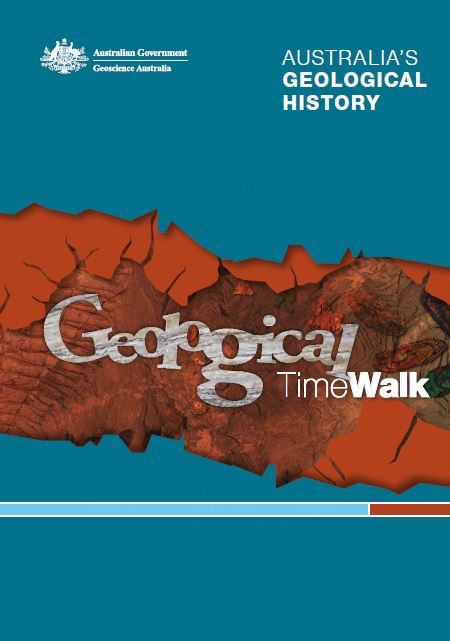fossil
Type of resources
Keywords
Publication year
Topics
-
This CD-ROM consists of 15 images and explanatory text detailing the nature of dinosaur fossils from Southern Australia as determined by scientists working along Australia's southeast coast. Find out about the dinosaurs that lived at polar latitudes between 120 to 110 million years ago and the fascinating methods they developed to cope with the climate of that region. The images include actual fossils discovered and reconstructions of dinosaurs and the plants and animals with which these dinosaurs were associated. Suitable for primary Years 5-6 an secondary Years 7-12.
-
This publication was developed as a guide to be used in conjunction with the Geoscience Australia TimeWalk but can also be used as a standalone guide on geological time. Each section in this publication discusses a single geological time interval, and outlines the major geological, climatic and biological events which occurred in that interval. Geological events include continental drift, the break-up and amalgamation of continental landmasses, mountain-building and major volcanic eruptions. Climatic events include changes in the content of the atmosphere and the occurrence of ice ages. Biological events include the evolution of major groups of organisms, the invasion of the land and major extinctions. Other events include changes in sea levels as well as major meteorite impacts. Each section also shows where rocks of a specific age are found in Australia and lists some of the continent's major mineral and energy resources formed during a particular time interval.
-
The black and white 55 page fossils resource contains information about what fossils are, what parts of living things become fossilised and the most common fossil groups. The process of fossilisation and geological time are also covered. 24 informative illustrated fact sheets cover a wide variety of plant, animal and trace fossils. Includes student activities suitable for primary Years 3-6 and secondary Years 7-10.
-
The 3D Models Bulk Set includes a class set of each of the following 3D paper models; - Nautiloid - Trilobite - Pterosaur - Triceratops - Volcano - Plate Tectonics Globe - Landslide - Slump
-
<p><b> Please note: This record has been made available internally for reference only</b> <p>PIMS is a search tool for discovery of survey and well data assets and physical samples held by the Geoscience Australia Repository. Data can be ordered and viewing of samples can be arranged via an online form. Although this is public data, fees are charged to cover the cost of transcription and delivery.
-
This collection consists of type specimens, illustrated or referred specimens which have been published in the scientific literature. Type specimens that have been published in literature of a wide variety of different macro and micro fossils. The Commonwealth Palaeontological Collection is a collection of type, illustrated referred or cited specimens of fossils which have been published in the scientific literature. This Collection was initiated by Federal Cabinet decision during the 1920s. When fossil specimens of any new species of animal or plant are found, for it to be of any future use in biostratigraphy, it of course must be analysed.
-
Legacy product - no abstract available
-
Diatom assemblages in sandy deposits of the 2004 tsunami at Phra Thong Island, Thailand may provide clues to flow conditions during the tsunami. The tsunami deposits contain one or more beds that fine upward, commonly from medium sand to silty very fine sand. Diatom assemblages of the lowermost portion of the deposit predominantly comprise of unbroken beach and subtidal species that live attached to sand grains. The dominant taxa shift to marine plankton species in the middle of the bed and to a mix of freshwater, brackish, and marine species near the top. These trends are consistent with expected changes in current velocities of tsunami through time. During high current velocities, medium sand is deposited; only beach and subtidal benthic diatoms attached to sediment can be incorporated into the tsunami deposit. High shear velocity keeps finer material, including planktonic diatoms in suspension. With decreasing current velocities, finer material including marine plankton can be deposited. Finally, during the lull between tsunami waves, the entrained freshwater, brackish, and marine species settle out with mud and plant trash. Low numbers of broken diatoms in the lower medium sand implies rapid entrainment and deposition, whilst selective breakage of marine plankton (Thalassionema nitzschioides, and Thalassiosira and Coscinodiscus spp.) in the middle portion of the deposit probably results from abrasion in the turbulent current before deposition.
-
Early Middle Cambrian faunas from the Jigaimara Formation from Elcho, Howard and Banyan Islands in the Arafura Basin, Northern Territory are analysed. They include the species: Pagetia hainesi sp. nov., P. aff. edura Jell, P. sp. indet., Xystridura templetonensis (Chapman), X. remorata Opik, X. ?filifera Opik, X. sp. indet., ptychoparioid sp. 1, ptychoparioid sp. 2, Oryctocephalites ?reynoldsi (Reed), Arthricocephalus sp. nov. and ?Itagnostus sp.. All indicate an age of early Templetonian (i.e. predating T. gibbus), and indicate a close similarity with the fauna of the Beetle Creek Formation of western Queensland
-
This entails publishing a formal analysis which, under the International Codes of Zoological and Botanical Nomenclature, must be accompanied by illustrations of specimens. These illustrated specimens can then become the 'ype specimens'. The type specimen acts as a reference upon which the understanding of each species relies. So, if any subsequent research worker wants to compare their material with, or to assign their material to a known species, the concept of that species is dependent on the type specimens and the research worker must refer to those type specimens.


